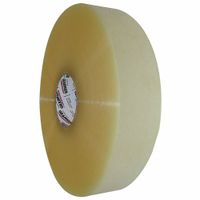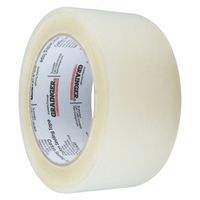Call +(254) 703 030 000 / 751 483 999 / 721 704 777
- Home
- Packaging Shipping
- Packaging Tapes Dispensers Machines
- Standard Packaging Tapes Dispensers Machines
- Acrylic Packaging Tapes
.....Read More
Frequently Asked Questions
What surfaces does acrylic packaging tape adhere to?
Acrylic packaging tape is known for its versatility and strong adhesive properties, making it suitable for a wide range of surfaces. It adheres well to:
1. **Corrugated Cardboard**: Ideal for sealing boxes, especially in shipping and storage applications.
2. **Plastic**: Works on various types of plastics, including polyethylene and polypropylene, commonly used in packaging.
3. **Metal**: Can be used on metal surfaces, making it useful in industrial settings.
4. **Glass**: Adheres to glass surfaces, though care should be taken to ensure the surface is clean and dry.
5. **Wood**: Suitable for unfinished and finished wood surfaces, provided they are clean and smooth.
6. **Paper**: Effective on paper products, including envelopes and paperboard.
7. **Painted Surfaces**: Can be used on painted walls and surfaces, though it may cause damage upon removal if the paint is not well-bonded.
8. **Fabric**: While not ideal for long-term use, it can temporarily adhere to certain fabrics.
For optimal adhesion, surfaces should be clean, dry, and free from dust, oil, or other contaminants.
How does acrylic packaging tape perform in high humidity?
Acrylic packaging tape performs well in high humidity conditions due to its water-resistant properties and strong adhesive formulation. Unlike rubber-based adhesives, acrylic adhesives are less susceptible to degradation when exposed to moisture, making them ideal for environments with high humidity. The adhesive in acrylic tape is designed to maintain its bond strength even when moisture levels are elevated, ensuring that the tape remains securely attached to surfaces.
Acrylic tapes are also UV resistant, which adds to their durability in various environmental conditions, including high humidity. This resistance to UV light prevents the adhesive from breaking down or losing its effectiveness over time, which is particularly beneficial for long-term storage or shipping in humid climates.
Furthermore, acrylic packaging tape has a stable performance across a wide temperature range, which complements its high humidity resistance. This stability ensures that the tape does not lose its adhesive properties or become brittle, which can be a concern with other types of adhesives in fluctuating temperatures and humidity levels.
However, while acrylic tape is generally effective in high humidity, it is important to ensure that the surface to which it is applied is clean and dry at the time of application. Any moisture or contaminants on the surface can affect the initial bond strength. Once applied correctly, acrylic packaging tape provides a reliable seal that withstands the challenges posed by humid environments, making it a preferred choice for packaging applications in such conditions.
Can acrylic packaging tape withstand extreme temperatures?
Acrylic packaging tape is known for its versatility and durability, but its performance in extreme temperatures can vary. Acrylic adhesive tapes are generally designed to withstand a wide range of temperatures, typically from -40°F (-40°C) to 200°F (93°C). This makes them suitable for both cold and hot environments, such as refrigerated storage or shipping in warm climates.
In cold temperatures, acrylic adhesive maintains its bond better than rubber-based adhesives, which can become brittle and lose adhesion. This makes acrylic tape a preferred choice for applications involving cold storage or transportation. However, in extremely low temperatures, even acrylic tape can become less flexible, which might affect its performance if the tape is applied under these conditions.
In high temperatures, acrylic tape generally performs well, maintaining its adhesive properties without melting or losing its bond. However, prolonged exposure to temperatures at the upper end of its range can eventually degrade the adhesive, leading to reduced effectiveness over time.
It's important to note that while acrylic tape can handle a broad temperature range, its performance can also be influenced by other factors such as the surface material, the presence of moisture, and the duration of exposure to extreme temperatures. For optimal performance, the tape should be applied at room temperature and allowed to cure before being exposed to extreme conditions.
In summary, acrylic packaging tape is suitable for use in a variety of temperature conditions, but its effectiveness can be compromised if exposed to extreme temperatures for extended periods or if not applied correctly. For critical applications, it is advisable to test the tape under specific conditions to ensure it meets the required performance standards.
What is the initial tack of acrylic adhesive like?
The initial tack of acrylic adhesive refers to its ability to quickly adhere to a surface upon contact without the need for sustained pressure. This characteristic is crucial for applications where immediate bonding is required. Acrylic adhesives are known for their balance of tack, peel, and shear properties, making them versatile for various substrates.
The initial tack is influenced by the adhesive's formulation, including the type and amount of tackifying resins used. These resins enhance the adhesive's stickiness, allowing it to bond rapidly to surfaces. The molecular structure of acrylic adhesives, typically composed of acrylate monomers, contributes to their inherent tackiness and flexibility.
Environmental factors such as temperature and humidity can also affect the initial tack. Higher temperatures generally increase tack by softening the adhesive, while lower temperatures may reduce it. Similarly, high humidity can enhance tack by preventing the adhesive from drying out too quickly.
Surface preparation is another critical factor. Clean, dry, and smooth surfaces typically result in better initial tack, as contaminants or rough textures can impede the adhesive's ability to make full contact.
In summary, the initial tack of acrylic adhesive is characterized by its quick bonding capability, influenced by its chemical composition, environmental conditions, and surface preparation. This property makes acrylic adhesives suitable for applications requiring immediate adhesion, such as in tapes, labels, and certain industrial processes.
How resistant is acrylic adhesive to solvents?
Acrylic adhesives are generally resistant to a wide range of solvents, but their resistance can vary depending on the specific formulation and the type of solvent. They exhibit good resistance to water, alcohols, and dilute acids and bases. However, their resistance to organic solvents like ketones, esters, and chlorinated solvents can be moderate to low.
Acrylic adhesives are cross-linked polymers, which contribute to their chemical resistance. The degree of cross-linking and the presence of any additives or modifiers in the adhesive formulation can significantly influence their solvent resistance. For instance, some acrylic adhesives are specifically formulated to enhance resistance to certain chemicals, making them suitable for more demanding applications.
In general, acrylic adhesives maintain their bond strength and integrity when exposed to mild solvents, but prolonged exposure to aggressive solvents can lead to softening, swelling, or degradation of the adhesive. This can result in a loss of adhesion and mechanical properties.
For applications requiring high solvent resistance, it is crucial to select an acrylic adhesive that is specifically designed for such conditions. Testing the adhesive under actual service conditions is recommended to ensure compatibility and performance.
Can acrylic packaging tape be applied by hand?
Yes, acrylic packaging tape can be applied by hand. Acrylic packaging tape is designed for sealing boxes and packages, and it is known for its strong adhesive properties and durability. When applying it by hand, follow these steps for optimal results:
1. **Preparation**: Ensure the surface of the box or package is clean, dry, and free from dust or grease. This will help the tape adhere better.
2. **Cutting the Tape**: Use a pair of scissors or a tape dispenser with a cutting edge to cut the tape to the desired length. A tape dispenser can make the process easier and more efficient.
3. **Application**: Start by placing the end of the tape on one edge of the box. Press down firmly to ensure it sticks well. Unroll the tape across the seam or opening of the box, applying even pressure as you go to avoid air bubbles or wrinkles.
4. **Sealing**: Once the tape is laid down, press it firmly along its entire length to ensure a secure seal. You can use your hand or a flat object to smooth out the tape and ensure it adheres properly.
5. **Finishing**: Cut the tape at the end of the seam, leaving a small overhang if necessary for extra security. Press down the edges to ensure they are firmly attached.
While applying acrylic packaging tape by hand is feasible, using a tape dispenser can improve efficiency and consistency, especially for larger volumes of packaging.
Is a tape dispenser necessary for applying acrylic packaging tape?
No, a tape dispenser is not strictly necessary for applying acrylic packaging tape, but it offers several advantages that make the process more efficient and effective. Without a dispenser, applying tape can be cumbersome and time-consuming. You would need to manually cut the tape with scissors or by tearing it, which can lead to uneven edges and wasted tape. Additionally, manually handling the tape can result in it sticking to itself or becoming tangled, further complicating the process.
A tape dispenser simplifies the application by providing a stable platform to hold the tape roll, allowing for smooth and consistent application. It typically includes a cutting blade, which ensures clean and precise cuts, reducing waste and improving the overall appearance of the sealed package. Dispensers also help maintain tension on the tape, ensuring it adheres properly to the surface, which is crucial for securing packages effectively.
Moreover, using a dispenser can significantly speed up the packaging process, especially in high-volume settings like warehouses or shipping departments. It reduces the physical strain on the user by minimizing repetitive motions and the need for manual cutting, which can be beneficial for ergonomic reasons.
In summary, while a tape dispenser is not absolutely necessary for applying acrylic packaging tape, it enhances efficiency, precision, and ease of use, making it a valuable tool for both personal and professional packaging tasks.

